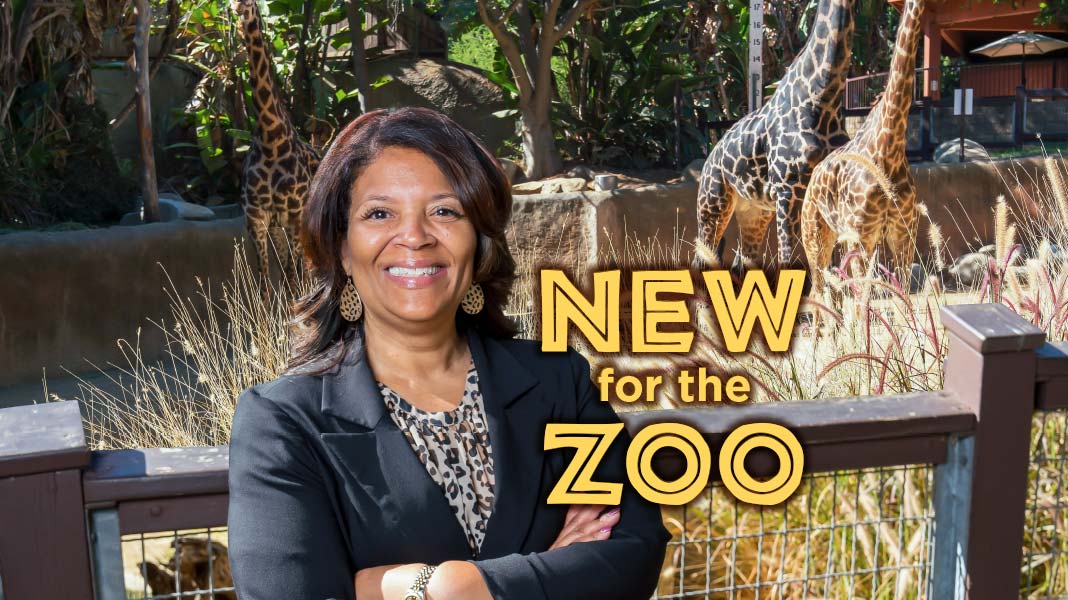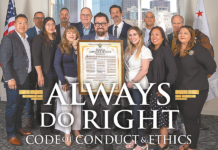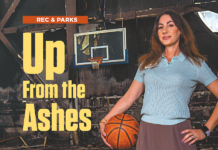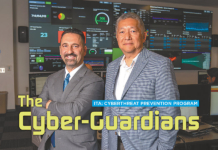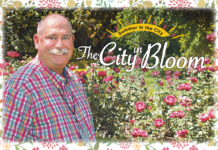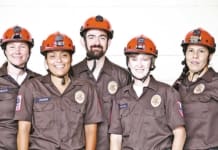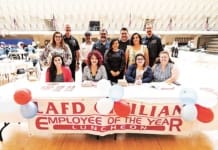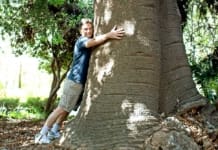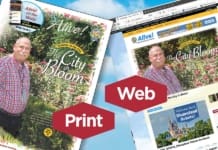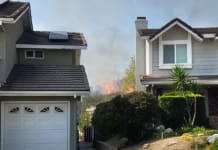Alive! photos by Summy Lam
This past summer, the City both made history and prepared for its next few decades. Denise Verret, 31 years of City service, Club Member, was named the CEO and Director of the Los Angeles Zoo and Botanical Gardens, the first African American director of any zoo accredited by the Association of Zoos and Aquariums (AZA).
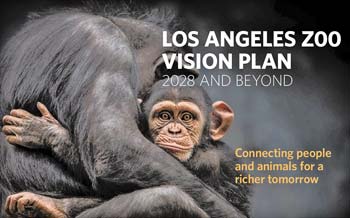
Denise, previously the Zoo’s Deputy Director who was featured in Alive!’s 50th anniversary tribute to the Zoo in 2016, has her eyes to the future. She’s leading the preparation and approval of a plan that will take the Zoo well into the future, the Los Angeles Zoo Vision Plan: 2028 and Beyond. The plan is expected to include expanded efforts into conservation, efforts to move many of its “backstage” programs (like the California Condor Recovery Program) into permanent exhibits, to rethink how it exhibits its animals, and much more. That plan is going through the environmental review phase now.
Prior to serving as the interim Zoo Director, Denise was the Zoo’s Deputy Director since 2000. During her 19-year tenure, she provided executive leadership over a variety of functions and major operations including finance, administration, information technology, human resources, admissions and guest relations, capital projects, planning and development, public relations, and education and interpretive programs. Among her many achievements include directing the development of the Zoo’s Strategic Plan, Vision Plan, and the Business and Marketing Plan. Denise began her City career in 1988 at the Office of the City Administrative Officer (CAO) until she was promoted to the L.A. Zoo. She earned her Bachelor of science degree in administrative studies at the University of California Riverside.
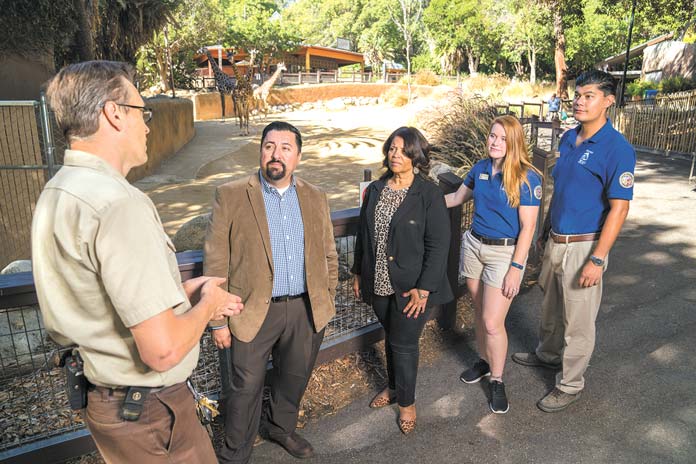
Denise became the first female African American Zoo Director of an Association of Zoos and Aquariums (AZA) accredited institution in its history. The AZA is a nonprofit organization dedicated to the advancement of zoos and aquariums since 1924 that has been accrediting zoos and aquariums since 1974. She serves as an AZA accreditation inspector, as well as a member of the Government Affairs and Diversity committees and was most recently sworn in as an elected member of the governing Board of the AZA.
Read all about Denise Verret’s plans for the future Zoo in this month’s Alive! Interview.

Quarterbacks in the Air

On Monday, Sept. 30, Club COO Robert Larios and Alive! editor John Burnes interviewed Denise Verret (pronounced Ver-ETT) in her office at the Los Angeles Zoo and Botanical Gardens. Denise, newly appointed and approved as the Zoo’s Chief Executive Officer and Zoo Director, has 31 years of City service and started working for the Zoo in 2000. Denise is a longtime Club Member.
Captain, thanks for hosting us today and speaking with us before we go on a ride-along later tonight.
Sure.
Thanks Denise, for giving us a tour of important stops at the Zoo this beautiful morning.
Denise Verret: Sure. I’m happy to have you here today.
Briefly give us a roadmap of how you got to your current position.
When I graduated from college, I didn’t really know what I wanted to do. I loved school. I thought I wanted to be a professional student. I was going to go get a Master’s degree, but my aunt was an Executive Administrative Assistant with the City in Public Works/Street Maintenance. And she said, “Why don’t you do an internship at the City over the summer, and then you can figure out what you want to do.” So I got an internship in the Office of the City Administrative Officer. And I thought oh, I’m going to start there, work there for a few months and then return to school and get an advanced degree. After that I’m going to get a job in the private sector. And 31 years later, here I am.
I started working in the CAO’s office where you get so much exposure and so much opportunity, whether it’s budget and policy or legislative matters, going before the mayor and the City Council, doing a lot of analysis and writing reports and having assignments based on departments. I was promoted a few times to be the Budget Analyst for the Recreation and Parks Dept., and at the time the Zoo was a division within Recreation and Parks. I was the analyst writing a lot of the reports that resulted in the Zoo being separated from Recreation and Parks and being created as its own separate Council-controlled department. So I was very familiar with the Zoo and that evolution. And when the first Zoo Director or Zoo General Manager at that time, Manuel Mollinedo, had an opportunity to hire an Assistant General Manager, I competed for the position. I got the job as the Assistant General Manager and had that position for 18 and a half years until I got the Zoo Director job.
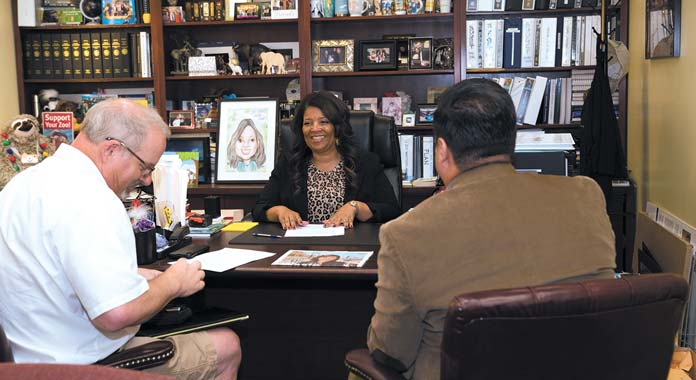
Right, just this past summer.
Yes, appointed by the mayor and confirmed by the Council. I’m just so humbled by the opportunity to really give back and make a difference in ways that I think will transcend and live long beyond me in this position.
Sure. You’re an LA native, right?
I grew up in the San Gabriel Valley. I was born and raised in Altadena. I went to public schools in Pasadena, and my husband and I raised our kids in Arcadia. That’s where we’ve lived for the last 17 years.
So this is your Zoo. From the moment you were born.
This is where I grew up going to the Zoo. My parents enjoyed bringing us here as children.
I never thought I’d ever work at the Los Angeles Zoo, but that is part of the beauty of being a City Employee. There are so many interesting opportunities that you can have working for the City of Los Angeles. You can work for one of our greatest ports. You can work for our busy airport. You can work in Sanitation, in the Recreation and Parks Dept., libraries, the Department of Aging, etc. There are so many unique opportunities that I just think working for the City is an amazing career for anybody.
Especially at this time when the City is putting forth all sorts of green efforts and is really rethinking the way the world works. It starts here.
Absolutely. It does all start here. At the Zoo, we have so much to offer the community as we think about species and being endangered and climate change and just what this Zoo and this community can do in partnership. It inspires me on a daily basis.
 The Zoo
The Zoo
So, now let’s talk about the Zoo. What does the Zoo do best?
The Zoo provides connections with nature. It allows you to be outdoors and to see animals that you would otherwise never be able to see. It is so important for people to have an opportunity to see the animals that we have here. It builds empathy. It shows people that the animals are something we should care about. It is so important for an institution like the Zoo to be vital to the community. We serve a very important purpose in that.
Give us a report card or a snapshot – where is the Zoo in 2019?
I feel like, if I had to give the Zoo a grade, I’d give it a B But I am very competitive and I always like to win, so I’m always striving for that A. We’re going to get that A; I am confident of it.
We have contributed significantly to conservation efforts. We have our signature California Condor program. We have our Mountain Yellow-Legged Frog and Peninsular Pronghorn programs. Conservation is the centerpiece of what the Zoo does.

Also, we want to do a better job of telling the community about what we’re doing and how we’re making a collective impact. We want our community to come here and see that our animals are getting the highest level of welfare and that all of the animals here are thriving.
And then we want to be welcoming to all, where everybody feels like they belong. The beauty of the Zoo is that we are a microcosm of all that is Los Angeles. The animals and the plants here are just as diverse as the community that we serve. When people walk through the gates they are all equal. It doesn’t matter what neighborhood they came from, what kind of job they have, what religion they practice – when they come here they are all the same. They have an experience seeing animals up close, being with their families and we hope being engaged and learning about the importance of caring for animals and their environment.
LA is just one community you’re part of. The Zoo is also part of the world zoo community too.
Absolutely. We are proud to be a member of the Association of Zoos and Aquariums, the AZA. It’s an accrediting organization, a membership organization, and we work collaboratively. There are about 235 Zoos and Aquariums in North America and a few around the world that belong. We work in partnership to save animals from extinction. We share information about animal care and husbandry, the science and the veterinary practice, our education and learning programs, the most beautiful part of that organization is the collaboration. We want all of us to be successful and thrive. We share information that allows us to leverage our collective knowledge and experiences so we can be the best we can be, and that’s special.
That sort of worldwide collaboration of zoos is unprecedented, right? It’s never happened before.
Right. We are not competing against one another. We need all of us to be successful to share in our common values and goals of making a difference in all of the communities that we serve.
Future Plans
What are the challenges facing the LA Zoo?
It’s getting our voice out in the community in a way that shares the important stories that we want to tell. There’s a lot of competition in the marketplace; we are in the entertainment capital of the world. It’s hard for us to get our voice out there and tell our stories about our conservation work. It’s so important for people in this community to know that we’re not only making a difference here in Griffith Park, but around the world..
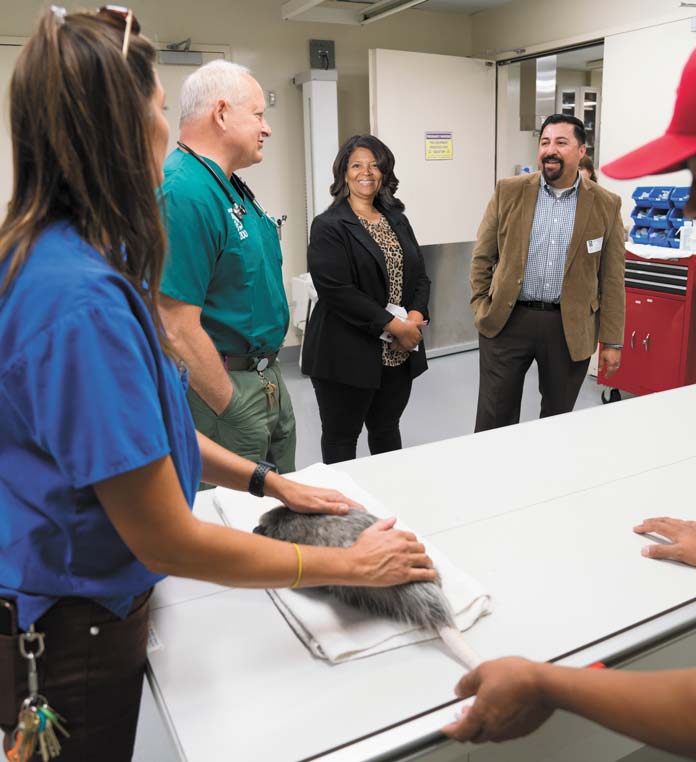

Talk about the plan you’re putting together for the Zoo’s future. What do you have in mind?
I want to transform the Zoo into something that is uniquely Los Angeles. There’s no city in the world like Los Angeles. and I am grateful every day that this is the City where I get to live and work in. I want to be a leader in animal welfare, in conservation, in community engagement. I want to build strategic alliances and partnerships. The vision plan reimagines our entire 133-acre campus. I want to leverage the unique resources in the City as we move that plan forward.
We are the entertainment capital of the world. We have amazing creative artists. We have culture. We have innovation and technology. We have the best institutions of higher learning. I want to leverage all that we have in Los Angeles to implement that plan going forward and think of different ways of designing animal exhibits and spaces so people will sit and reflect and engage. We have the California section, for example. We’re going to exhibit the California condor for the first time in our history. That is our signature conservation effort, but right now none of our visitors get to see condors.
Because they’re housed and cared for in the back.
Right. It’s an off-exhibit conservation breeding program. Being able to exhibit that California Condor Program is going to be able to allow us to tell that conservation story even more. We’re going to tell more of our conservation stories and provide larger, more expansive exhibits.

I’ve talked about wanting to build ecosystems and look at animals in a multiple-species exhibit and provide our visitors with a different experience. Maybe in the fall and winter months you’ll find one group of animals in a particular space, but when you come in the spring and the summer months we might have a different group of animals, and there will be an opportunity for rotation based on seasonality. It gives animals a different experience, which is enriching. It gives our visitors a different experience. I want to think of all types of innovative ways that we might change the experience from what it is right now.
What about those things like conservation? Those aren’t the easiest to see, to witness. I know you just hired your first…
Director of Conservation.

Right. That’s really a big deal. But how do you exhibit that?
Part of the vision plan is going to allow us to dedicate space for what we consider off-exhibit conservation breeding centers, where we’re able to breed animals in captivity and then release them back out into the wild. Right now we have that program for the mountain yellow-legged frog, but the space that they occupy is not the most ideal space. Even though they take that space and are so extremely innovative and utilize a lot of technology, I’d like to have more space dedicated to captive breeding programs that will allow us to return species that are threatened and endangered back into the wild. A lot of people don’t realize that there are local species right now in our own backyards that are critically endangered, and our ability to invest in those types of programs is very vital to our future, and it ensures that we are vital place in the community and that we play a role locally.
What kind of challenges and opportunities does that present?
With climate change, we hear reports about animals going extinct at an alarming rate. For zoos, we have expertise in breeding animals in human care in small populations. In the wild you find fragmented populations due to poaching, habitat loss, and human/animal conflict and encroachment. We are able to successfully breed animals in captivity, and we can take that expertise and help dwindling populations in the wild to thrive and reestablish themselves. That role is one that we own, and we are collectively making a difference in a way that really no other group can. That mission is just so important and it’s bigger than all of us. We have a duty and responsibility if we want to keep the animals from disappearing off of this planet.
Do you want the Zoo to grow?
Definitely. We want the Zoo to be synonymous with Los Angeles, so that people take pride in it. We are a world-class city, and a world-class city deserves a world-class zoo. We have world-class sports teams and academic institutions and arts and cultural facilities; we want the Los Angeles Zoo to be on that world-class stage at that level, and the vision plan is going to help us get there.
What is the official name of the vision plan?
The Los Angeles Zoo Vision Plan: 2028 and Beyond. We’re eyeing the Olympics as an opportunity to get some early phases completed. Los Angeles will be only the third city that has held the Olympics three times. London and Paris are the other two. That says a lot about Los Angeles, and we want to be ready when people come here from all across the globe to show them that the Zoo is on the world stage, too.
Right. Have you released that vision statement report yet?
Not yet. An Environmental Impact Report is being prepared right now. Public Works/ Engineering is managing that process, and it is anticipated that the EIR will be completed by July 2020.
Talk about the job done by your predecessor, John Lewis.
John came at a time when we were undergoing a lot of construction. The Zoo Capital Program was in full swing, so there was a lot of building going on. Building in a zoo can be a complicated and challenging experience. He led that effort. $172 million was invested in the Zoo. We built a new exhibit for our reptiles and amphibians, a new exhibit for our rainforest, new Elephants of Asia, and a new animal health center, which you saw today. All of that helped to transform the Zoo into a modern zoological facility. We’ve won exhibit awards. Our elephant program has been cited as a model by our AZA accreditation team, and John led that entire effort. I studied and learned from his animal knowledge and expertise. His more than 40 years in this profession are very well regarded and respected by our professional colleagues.
Marketing the After-Hours
Talk about the after-hour events like Roaring Nights and Zoo Lights. How are they doing?
Well, we started the evening events, Roaring Nights and Brew at the Zoo to attract the 21 and older crowd. The idea was, how can we engage the younger demographic who maybe hadn’t been to the Zoo since they were young with their own parents or just hadn’t been at all? We wanted to target that demographic with music and have them say, “Wow, that was a cool experience. I saw animals. The Zoo looks great. I should tell my friends about it and we should come back.” We want to have a demographic that represents all of Los Angeles, so that millennial group is very important to us. They’re very advocate-minded. They like to make a difference and make an impact. So we want to be able to connect with that audience and build them as advocates for the Zoo.
The Zoo Lights Program [during the holiday sea¬son] is another way that we can bring in an audi¬ence and build our attendance and awareness in an evening event. We all remember that the DWP’s Griffith Park holiday lighting event was going away because of a construction project, and we wanted to leverage that audience. My hus¬band and I experienced it with our own kids who were in the back seats of our car. We wanted to give residents an opportunity to come and see a beautiful light program during the holiday season.
And it’s been successful.
We get nearly 240,000 people in about 50 nights. People are always looking for something safe to do with their families in the evening during the holiday season. It’s not just for families though. It’s for the young and old, single or with families, or just friends. We see great attendance during that time of the year. And of course the weather, even during the cold winter months, really works in our favor.
A Culture of Mission
What do you wish people knew about the Zoo?
I’ve talked about working to save animals from extinction every day, working both here and in the wild. But I’m not talking about only the ani¬mal care experts and the veterinarians who care for the animals every day. We have a culture with everybody who works here – no matter whether you are the custodian, a ticket seller, a payroll processor – everybody plays a role in saving ani¬mals from extinction because everything is very interconnected. Some people might think that achieving the mission is only for the animal care experts, but it’s not. Everybody plays a role.
Without the LA Zoo the incredible condor was going extinct and would never have come back.
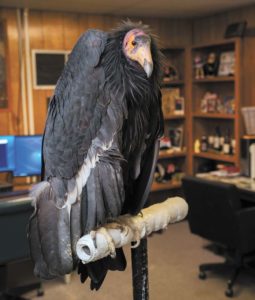
That is 100 percent correct. There are many others like that that, too. The mountain yellow-legged frog is another animal that was on the brink of extinction in the San Gabriel Mountains, in our own backyard. And we have been breeding tadpoles and releasing a thousand here and 500 there with the hope of restoring them to their natural habitat so that we can have a thriving population in the future.
How good are the employees here?
They are the best people and best employees in the entire world. They believe in the mission. They work tirelessly every day with pride, passion and purpose. I talk to as many of them as I possibly can. I think any executive needs to under-stand that one of the most important characteris¬tics in being an effective leader is having empathy and caring about people as individuals. When people come to work every day they bring their personal lives with them. It’s important to care about people and let people know that. I could not do my job without them. They inspire me every day, and I’m just very proud and humbled to lead this group of people.
What do you love about what you do? What’s your greatest satisfaction?
I love working for a place that is bigger than me, that is mission-oriented. I’m driven by wanting to be successful. I love thinking about and talking to people about building strategic alliances to leverage our footprint. I love thinking of ways to partner the Zoo with organizations that are not necessarily traditional partners so that we can connect with as diverse an audience as possible.
An example would be …
I’ve been talking to Danielle Brazell, the General Manager of Cultural Affairs.
Sure.
I am trying to think of how the Zoo can connect with the arts so that we can be out there in a dif¬ferent way. I love open mic spoken poetry, so I’m wondering if we could do a poetry slam here and have people use the power of voice and the spoken word to talk about climate change or endan¬gered species. Or, is there a way to curate art that we could exhibit with animals as the backdrop? How can we leverage partnerships to build new audiences and have people think about the Zoo in ways that they may not have thought about before? I’m always willing to talk to anybody to have those kinds of conversations to think about things outside what might be a traditional animal-related partnership.
And how can we engage our colleges and univer¬sities as partners in research projects? We have a Director of Research here, and we’re always doing studies. Is there a way to partner with uni¬versities to do that? I don’t know if a lot of people know that we have a magnet school on the Zoo’s property? North Hollywood High School has a Zoo magnet program that has resided in our far south parking lot for more than 25 years. They have 300 students, 9th through 12th grade.
Making History
And last but not least, Denise, you’ve made history. You are the first African-American female Zoo Director at an AZA-accredited Zoo institution in the country.
It is such an incredible opportunity.
Congratulations from the Club!
Thank you so, so much.
Well deserved. How do you feel about that?
It is humbling. I never in my life dreamed that I would be the first of anything. But being the first means that I will not be the last, right?
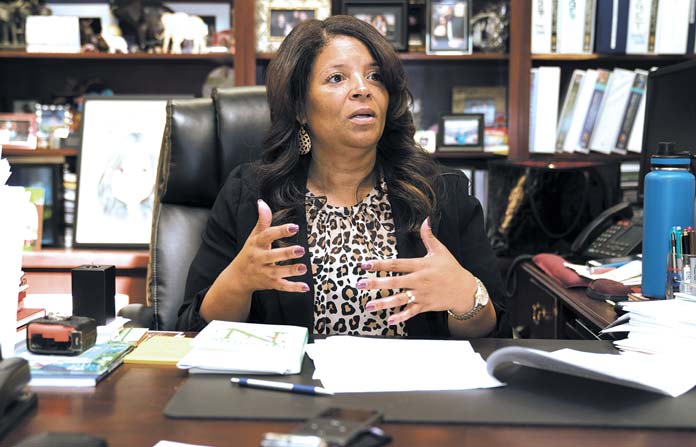
Right.
Achieving a role like this allows other women, and in particular women of color, to see someone in this type of a leadership role. Seeing is believing. When you see someone, you think, I can do that too. It is my duty and my obligation to give back, to mentor and help people along their own professional journeys and help them to understand how they can achieve anything that they put their mind to. It is the part of my job that I absolutely love, giving people an opportunity to learn about my journey and give them some advice on how they might chart their own course. I try to do it on a regular basis.
I will speak to any group. I spoke to a leadership group at the California Science Center and have since emailed with people that were in that group and given them ideas and resources to help them in a variety of ways.
And you have a leadership role at the accrediting organization, the AZA. You’re on its board of directors.
Yes. I spoke at the AZA conference this year to the First-Time Attendees group, and people have followed up with me and connected with me. I feel it’s my responsibility to give back, and I will do it until the day that I step out of this door and retire and move into my next phase.
Who in the City mentored you?
Phyllis Currie. She was an Assistant City Administrative Officer when I first began as an intern in the CAO’s Office. She was the first African-American woman to have that role and she always encouraged and challenged me and made me believe I could do whatever I accomplished. She advised me that sometimes you have to get out of your comfort zone. You might have to change assignments even though you might be comfortable in what you’re doing, but you need to constantly challenge yourself. She was there when I was confirmed by the City Council because we are still friends. I acknowledged her because she was the person who inspired and mentored me, and I intend to give back to others in the way that she gave back to me.
Phyllis Currie was also an Employees Club board member. She was important to the Club, too.
I didn’t know that. Let me just say that I appreciate my Club membership. I think it is such a valuable resource. It’s something that all employees should be members of, and I thank you for all that you do for the employees.
Well, thank you, Denise! Now, since you’re a huge LA sports fan, who’s going to win the next championship – the Dodgers, the Rams or the Clippers? Those are your teams.
One hundred percent, the Dodgers. [The interview was conducted Sept. 30. – Ed.] They have the first opportunity to do so, only to be followed closely by the Clippers and the Rams.
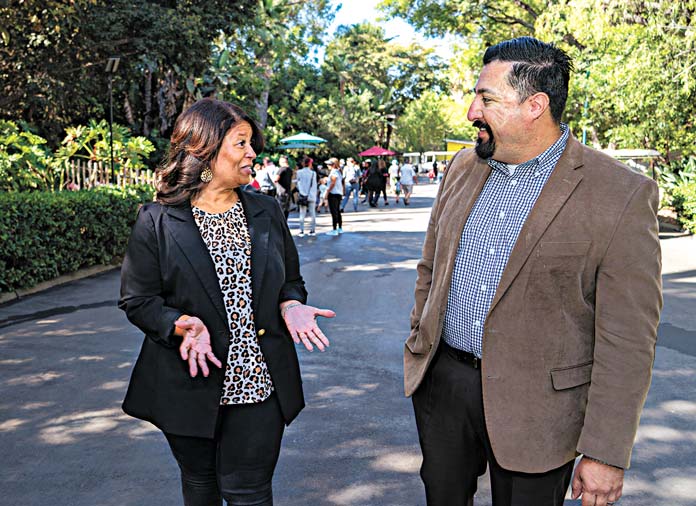
The Zoo will be winning plenty of awards, too.
That reminds me – I just finished reading this book by Richard Louv. It’s called Vitamin N. It’s the essential guide to a nature-rich life. He talks about what he calls nature-deficit disorder. You’re aware of vitamin A, vitamin B, vitamin D?
Sure.
Well, he introduces “vitamin N.” People are very connected to technology these days. But it’s important to disconnect and to be out in nature. This book gives 500 ways to enrich the health and happiness of your family and your community. I believe that animals and people are connected to nature, and that connection contributes to our overall health and well-being.
If you’ve ever had a pet, they become bonded and part of your family. I see the Zoo as part of the cure to this nature-deficit disorder. We provide a very important place and space for people to be outdoors, have connections, see animals and feel better because of it. I want the Los Angeles Zoo to be a place and space where we not only save animals from extinction, but we provide connections and opportunities for this community to be outdoors and let that contribute to their overall health and well-being. We are going to be part of the cure.
Right. Denise, thank you so much for the tour. Thank you for your vision and your leadership, and congratulations again, from the Club.
Thank you so much. And you’re welcome.
BEHIND THE SCENES
Club Director of Marketing Summy Lam (foreground) photographs Denise Verret, CEO and Director, LA Zoo, Club Member, and Club COO Robert Larios at the giraffe exhibit. |


